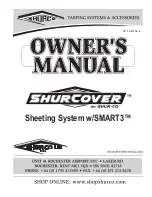
4.
If present, check the condition of the insulation
material around the exhaust pipe between the
turbocharger and the ATD.
5.
Check the ATD mounting bands for tightness.
Tighten to 30 lbf·ft (41 N·m) if needed. Do not
overtighten.
6.
Check for leaks around the clamps that attach
the ATD in the ATS, and around the clamps that
retain the DPF in the ATD. No leaks are allowed
anywhere in the system.
7.
Check all sensors attached to the ATD for leaks
or damaged wires. No leaks are allowed.
8.
Check the DPF exterior surface for dents or
other damage. See Item A of
. A dent over
3 inches (76 mm) in diameter and 1/4-inch (6-
mm) deep could cause internal damage to the
DPF, causing it to malfunction.
9.
Check for heat discoloration on the surface of
the ATD. Heat discoloration may indicate internal
damage; especially around the DPF.
10. Check any wires, lines, or hoses within 4 inches
(10 cm) of the exhaust system for heat damage.
Repair or reroute as needed.
49–02 CAT CGI Bellows
Replacement
On vehicles with CAT EPA07 compliant engines, re-
place the CGI bellows at the M3 maintenance inter-
val to prevent a later failure.
NOTICE
A leak in the CGI piping, including the bellows,
will allow unfiltered air and contaminants into the
engine intake, and can cause serious engine
damage.
1.
Park the vehicle, set the parking brake, chock
the wheels.
2.
Open the hood.
3.
Remove the right side inner fender/splash shield
as needed.
4.
Remove the CGI piping between the engine and
aftertreatment device (ATD).
See
5.
On the workbench, remove the CGI bellows from
the exhaust piping. Do not damage the piping.
NOTE: The following step, and its substeps, is
to be done without the bellows installed. This
will align the pipes so that the bellows can be
installed correctly.
6.
Install the CGI piping (without CGI bellows) and
align piping.
6.1
Attach the aft CGI pipe to the ATD.
6.2
Attach the forward CGI pipe to the en-
gine.
NOTICE
When the CGI pipes and bellows are installed,
there should be approximately 3/4 inch (19 mm)
clearance from the main bellows. Contact between
the bellows could result in an exhaust leak, which
in this case may allow ingestion of contaminants
into the engine causing engine damage.
6.3
Use a straightedge to align the pipes so
that the pipe ends that attach to the bel-
lows are parallel and concentric.
NOTICE
When shortening the CGI pipe(s), it is critical to
leave a minimum of 1 inch (25.4 mm) of straight
pipe on the end of each CGI pipe to allow for pipe
insertion and clamp clearance. Failure to do this
could result in an exhaust leak, which in this case
may allow ingestion of contaminants into the en-
gine causing engine damage.
7.
Once the pipes are aligned, measure the pipe
gap between the CGI pipes and record the dis-
tance. See
, Ref. A.
The existing pipe gap is designed at 10 inches
(254 mm). A 10.75 inches (273 mm) pipe gap is
required for the replacement CGI bellows and
clamps. This requires one or both of the CGI
pipes to be shortened.
8.
Using a yellow paint pen, mark the pipes 1.5
inches (38 mm) in from the end of each pipe.
These two marks will be used to center the bel-
lows between the two pipes.
Exhaust
49
Columbia Maintenance Manual, September 2015
49/4
Содержание CL112 2015
Страница 2: ......
Страница 4: ......
Страница 10: ......
Страница 32: ......
Страница 34: ......
Страница 38: ......
Страница 40: ......
Страница 42: ......
Страница 44: ......
Страница 46: ......
Страница 48: ......
Страница 50: ......
Страница 52: ......
Страница 60: ......
Страница 62: ......
Страница 66: ......
Страница 68: ......
Страница 74: ......
Страница 86: ......
Страница 94: ......
Страница 96: ......
Страница 104: ......
Страница 106: ......
Страница 116: ......
Страница 118: ......
Страница 120: ......
Страница 122: ......
Страница 128: ......
Страница 140: ......
Страница 142: ......
Страница 152: ......
Страница 156: ......
Страница 164: ......
Страница 166: ......
Страница 168: ......
Страница 172: ......
Страница 176: ......
Страница 178: ......
Страница 180: ......




































